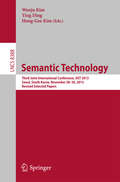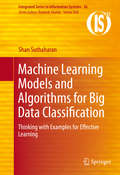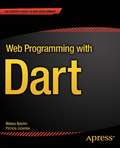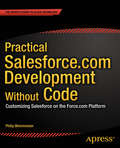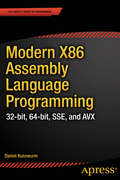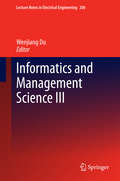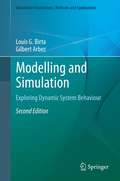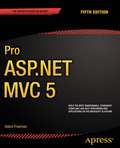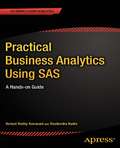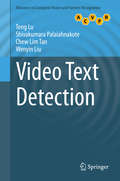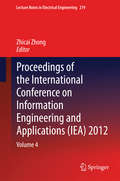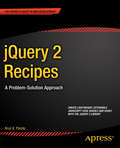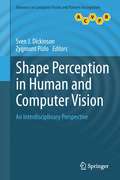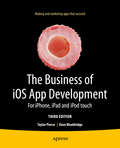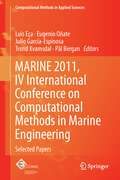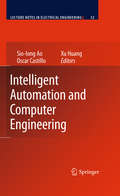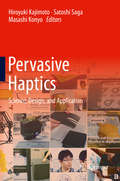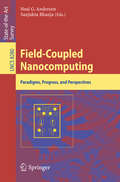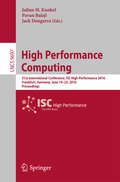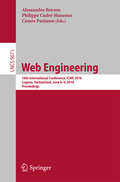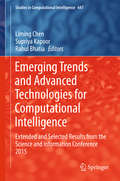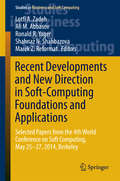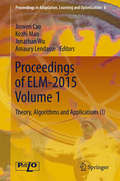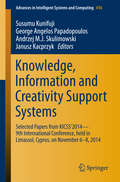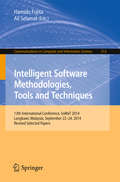- Table View
- List View
Semantic Technology
by Ying Ding Wooju Kim Hong-Gee KimThis book constitutes the proceedings of the Third Joint International Semantic Technology Conference, JIST 2013, held in Seoul, South Korea, in November 2013. The 32 papers, included four tutorials and 5 workshop papers, in this volume were carefully reviewed and selected from numerous submissions. The contributions are organized in topical sections on semantic Web services, multilingual issues, biomedical applications, ontology construction, semantic reasoning, semantic search and query, ontology mapping, and learning and discovery.
Machine Learning Models and Algorithms for Big Data Classification
by Shan SuthaharanThis book presents machine learning models and algorithms to address big data classification problems. Existing machine learning techniques like the decision tree (a hierarchical approach), random forest (an ensemble hierarchical approach), and deep learning (a layered approach) are highly suitable for the system that can handle such problems. This book helps readers, especially students and newcomers to the field of big data and machine learning, to gain a quick understanding of the techniques and technologies; therefore, the theory, examples, and programs (Matlab and R) presented in this book have been simplified, hardcoded, repeated, or spaced for improvements. They provide vehicles to test and understand the complicated concepts of various topics in the field. It is expected that the readers adopt these programs to experiment with the examples, and then modify or write their own programs toward advancing their knowledge for solving more complex and challenging problems. The presentation format of this book focuses on simplicity, readability, and dependability so that both undergraduate and graduate students as well as new researchers, developers, and practitioners in this field can easily trust and grasp the concepts, and learn them effectively. It has been written to reduce the mathematical complexity and help the vast majority of readers to understand the topics and get interested in the field. This book consists of four parts, with the total of 14 chapters. The first part mainly focuses on the topics that are needed to help analyze and understand data and big data. The second part covers the topics that can explain the systems required for processing big data. The third part presents the topics required to understand and select machine learning techniques to classify big data. Finally, the fourth part concentrates on the topics that explain the scaling-up machine learning, an important solution for modern big data problems.
Web Programming with Dart
by Moises Belchin Patricia JuberiasWeb Programming with Dart is for programmers who want to master the new Dart programming language from Google, and also web developers who want to understand how Dart can integrate perfectly with HTML5 and CSS3. With this book you will understand the ins and outs of the language, how the tools work, and how to get the most from the core functions and libraries. Web Programming with Dart is a practical, example-led book, with case studies involving developing UI animations for the web, working with web services such as JSON, server side Dart applications, and the new Polymer. dart library for advanced HTML UI web components generation. Take a full tour of Dart's core features and its advanced functionalityLearn the tools that come with Dart SDK and the most important libraries. Additionally you will work with the newest Polymer. dart library for web component creation. Develop your own command-line and server side applications and, of course, web applications with Dart.
Practical Salesforce.com Development Without Code
by Philip WeinmeisterAre you facing a challenging Salesforce. com problem--say, relating to automation, configuration, formulation, or reporting--that you can't quite crack? Or maybe you are hoping to infuse some creativity into your solution design strategy to solve problems faster or make solutions more efficient? Practical Salesforce. com Development Without Code shows you how to unlock the power of the Force. com platform to solve real business problems--and all without writing a line of code. Adhering to Salesforce. com's 'clicks, not code' mantra, Salesforce. com expert Phil Weinmeister walks you through different business problems and identifies effective, creative--and proven--approaches to solutions using the platform's declarative framework. If you are a Salesforce. com administrator, analyst, consultant, or developer, you can attest to the insatiable appetite of users for new functionality. Your clients expect solutions--and now. By adopting Practical Salesforce. com Development Without Code as your guide, you will learn how to deliver business solutions within Salesforce. com by combining analysis, creativity, and logic with some of its core elements, including validation rules, workflow rules, and formula fields. In addition, Weinmeister dissects and explains the most useful functions and features for developers, and shows you how to use them. Among other things, you will learn how to: Build objects, fields, and relationships to establish a sensible data modelAutomate business processes by using workflow rules and flows (Visual Workflow)Utilize functions and develop formulas effectively for a variety of business needsDevelop intricate approval processes to handle exception scenariosEmploy publisher actions to drive additional functionality from the Chatter feedManage your data using Data LoaderBest of all, Weinmeister uses real-life business scenarios and visuals to keep you engaged and learning something new with every page you read. Practical Salesforce. com Development Without Code will help you absorb the principles behind dozens of creative and thoughtful ways to solve your business problems. Applying the lessons learned from this how-to guide will ultimately save you time and ensure that your clients or internal customers are well satisfied and productive
Modern X86 Assembly Language Programming
by Daniel KusswurmModern X86 Assembly Language Programming shows the fundamentals of x86 assembly language programming. It focuses on the aspects of the x86 instruction set that are most relevant to application software development. The book's structure and sample code are designed to help the reader quickly understand x86 assembly language programming and the computational capabilities of the x86 platform. Book appendixes can be downloaded here: http: //www. apress. com/9781484200650?gtmf=sMajor topics of the book include the following:32-bit core architecture, data types, internal registers, memory addressing modes, and the basic instruction setX87 core architecture, register stack, special purpose registers, floating-point encodings, and instruction setMMX technology and instruction setStreaming SIMD extensions (SSE) and Advanced Vector Extensions (AVX) including internal registers, packed integer arithmetic, packed and scalar floating-point arithmetic, and associated instruction sets64-bit core architecture, data types, internal registers, memory addressing modes, and the basic instruction set64-bit extensions to SSE and AVX technologiesX86 assembly language optimization strategies and technique
Informatics and Management Science III: 206 (Lecture Notes in Electrical Engineering)
by Wenjiang DuThe International Conference on Informatics and Management Science (IMS) 2012 will be held on November 16-19, 2012, in Chongqing, China, which is organized by Chongqing Normal University, Chongqing University, Shanghai Jiao Tong University, Nanyang Technological University, University of Michigan, Chongqing University of Arts and Sciences, and sponsored by National Natural Science Foundation of China (NSFC). The objective of IMS 2012 is to facilitate an exchange of information on best practices for the latest research advances in a range of areas. Informatics and Management Science contains over 600 contributions to suggest and inspire solutions and methods drawing from multiple disciplines including:<P><P> Computer Science<P> Communications and Electrical Engineering<P> Management Science<P> Service Science<P> Business Intelligence<P> Management Science<P> Service Science<P> Business Intelligence<P>
Modelling and Simulation
by Louis G. Birta Gilbert ArbezThis textbook presents a practical introduction to the fundamental aspects of modelling and simulation. It provides the necessary foundations both for those wishing to learn about this methodology and also for those who have a need to apply it in their work. Illustrative examples are drawn from projects formulated within the domains of both DEDS and CTDS. Features: presents a project-oriented perspective; describes an activity-based conceptual modelling framework (ABCmod) for DEDS; includes a new chapter that presents a novel world view, the Activity-Object world view, which eases the translation of a conceptual model specification in the ABCmod framework into a simulation program; contains numerous illustrative examples, useful algorithms, exercises and projects; includes a primer on probability, a concise guide to the GPSS programming environment and an overview of relevant MATLAB features in the appendices; provides supplementary software and teaching support material at an associated website.
Pro ASP.NET MVC 5
by Adam FreemanThe ASP. NET MVC 5 Framework is the latest evolution of Microsoft's ASP. NET web platform. It provides a high-productivity programming model that promotes cleaner code architecture, test-driven development, and powerful extensibility, combined with all the benefits of ASP. NET. ASP. NET MVC 5 contains a number of advances over previous versions, including the ability to define routes using C# attributes and the ability to override filters. The user experience of building MVC applications has also been substantially improved. The new, more tightly integrated, Visual Studio 2013 IDE has been created specifically with MVC application development in mind and provides a full suite of tools to improve development times and assist in reporting, debugging and deploying your code. The popular Bootstrap JavaScript library has also now been included natively within MVC 5 providing you, the developer, with a wider range of multi-platform CSS and HTML5 options than ever before without the penalty of having to load-in third party libraries. What you'll learn Gain a solid architectural understanding of ASP. NET MVC 5 Explore the entire ASP. NET MVC Framework as a cohesive whole Learn what's new in version 5 and how best to apply these new features to your own work See how MVC and test-driven development work in action Capitalize on your existing knowledge quickly and easily through comparison of features in classic ASP. NET to those in ASP. NET MV Who this book is for This book is for web developers with a basic knowledge of ASP. NET and C#who want, or need, to start using the new ASP. NET MVC 5 Framework. Table of Contents Part I: Introducing ASP. NET MVC 5 1. What's The Big Idea 2. Your first MVC Application 3. The MVC Pattern 4. Essential Language Features 5. Working with Razor 6. Essential Tools for MVC 7. Sports Store: A Real Application 8. Sports Store: Navigation 9. Sports Store: Cart 10. Sports Store: Mobile 11. Sports Store: Admin 12. Sports Store: Security and Finishing Touches 13. Deployment Part II: ASP. NET MVC 5 In Detail 14. Overview of MVC5 Projects 15. URL Routing 16. Advanced Routing Features 17. Controllers and Actions 18. Filters 19. Controllers Extensibility 20. Views 21. Helper Methods 22. Templated Helper Methods 23. URL and Ajax Helper Meothods 24. Model Binding 25. Model Validation 26. Bundles 27. WebAPI and Single Page Applications
Practical Business Analytics Using SAS
by Venkat Reddy Konasani Shailendra KadrePractical Business Analytics Using SAS: A Hands-on Guide shows SAS users and businesspeople how to analyze data effectively in real-life business scenarios. The book begins with an introduction to analytics, analytical tools, and SAS programming. The authors--both SAS, statistics, analytics, and big data experts--first show how SAS is used in business, and then how to get started programming in SAS by importing data and learning how to manipulate it. Besides illustrating SAS basic functions, you will see how each function can be used to get the information you need to improve business performance. Each chapter offers hands-on exercises drawn from real business situations. The book then provides an overview of statistics, as well as instruction on exploring data, preparing it for analysis, and testing hypotheses. You will learn how to use SAS to perform analytics and model using both basic and advanced techniques like multiple regression, logistic regression, and time series analysis, among other topics. The book concludes with a chapter on analyzing big data. Illustrations from banking and other industries make the principles and methods come to life. Readers will find just enough theory to understand the practical examples and case studies, which cover all industries. Written for a corporate IT and programming audience that wants to upgrade skills or enter the analytics field, this book includes: More than 200 examples and exercises, including code and datasets for practice. Relevant examples for all industries. Case studies that show how to use SAS analytics to identify opportunities, solve complicated problems, and chart a course. Practical Business Analytics Using SAS: A Hands-on Guide gives you the tools you need to gain insight into the data at your fingertips, predict business conditions for better planning, and make excellent decisions. Whether you are in retail, finance, healthcare, manufacturing, government, or any other industry, this book will help your organization increase revenue, drive down costs, improve marketing, and satisfy customers better than ever before.
Video Text Detection
by Tong Lu Shivakumara Palaiahnakote Chew Lim Tan Wenyin LiuThis book presents a systematic introduction to the latest developments in video text detection. Opening with a discussion of the underlying theory and a brief history of video text detection, the text proceeds to cover pre-processing and post-processing techniques, character segmentation and recognition, identification of non-English scripts, techniques for multi-modal analysis and performance evaluation. The detection of text from both natural video scenes and artificially inserted captions is examined. Various applications of the technology are also reviewed, from license plate recognition and road navigation assistance, to sports analysis and video advertising systems. Features: explains the fundamental theory in a succinct manner, supplemented with references for further reading; highlights practical techniques to help the reader understand and develop their own video text detection systems and applications; serves as an easy-to-navigate reference, presenting the material in self-contained chapters.
Proceedings of the International Conference on Information Engineering and Applications (IEA) 2012: 219
by Zhicai ZhongInformation engineering and applications is the field of study concerned with constructing information computing, intelligent systems, mathematical models, numerical solution techniques, and using computers and other electronic devices to analyze and solve natural scientific, social scientific and engineering problems. <P><P> Information engineering is an important underpinning for techniques used in information and computational science and there are many unresolved problems worth studying. The Proceedings of the 2nd International Conference on Information Engineering and Applications (IEA 2012), which was held in Chongqing, China, from October 26-28, 2012, discusses the most innovative research and developments including technical challenges and social, legal, political, and economic issues.<P> A forum for engineers and scientists in academia, industry, and government, the Proceedings of the 2nd International Conference on Information Engineering and Applications presents ideas, results, works in progress, and experience in all aspects of information engineering and applications.
jQuery 2 Recipes
by Arun K. PandejQuery is often referred to as the 'write less, do more' JavaScript library. It allows a few clear lines of elegant, well-tested, code to replace many pages of complex hand-coded script, speeding development times and providing substantial cost savings. You will find jQuery 2 Recipes' problem-solution approach to be an excellent value and a feature-packed resource as you begin to include jQuery in your own projects. This book is bursting with fully-worked example recipes showing the core jQuery frameworks (jQuery, jQuery Mobile, jQuery UI) in action. Starting with fundamental principals and progressing to more advanced topics you'll be shown how to make the very best use of jQuery every step of the way. Early on, you'll learn to work confidently with dynamic data and to handle the jQuery events that form the foundation of your application. We'll then build on this foundation to demonstrate how fully working user-interface animations and AJAX data-validation can be constructed within jQuery. We'll show how add-on libraries like jQwidgets can be deployed to create professional quality apps for both the desktop and web with minimal coding. Finally, a full set of debugging and error-handling recipes is included to help you track down bugs and ensure your code is as robust as it can be. What you'll learn This book contains a comprehensive collection of recipes that will help you solve a wide range of jQuery 2. 0 problems. Follow working examples of the main features of all three core jQuery frameworks (jQuery, jQuery UI and jQuery Mobile) in action. See how to integrate jqWidgets into your application effectively. Learn the techniques to create and implement custom animations and effects using jQuery methods. Follow tried-and-tested debugging recipes to streamline your applications. Who this book is for This book is written for developers with a basic working knowledge of jQuery, HTML and CSS, who want to broaden their learning. You should be comfortable creating basic programs and understand the role that jQuery plays within an application before you begin reading. Table of Contents Chapter 1 Introduction Chapter 2 jQuery Fundamentals Chapter 3 jQuery Selectors Chapter 4 jQuery Selectors Filtering and Expansion Chapter 5 DOM Traversing Chapter 6 DOM Manipulation Chapter 7 Event Handling Chapter 8 jQuery Effects and Animation Chapter 9 jQuery AJAX Chapter 10 jQuery UI Chapter 11 jQuery Mobile Chapter 12 jqWidgets Framework Appendix A Basic HTML5 and CSS3 Appendix B Web Console Appendix C Deploy Web Application Appendix D Logging, Error Handling, and Debugging
Shape Perception in Human and Computer Vision: An Interdisciplinary Perspective
by Sven J. Dickinson Zygmunt PizloThis comprehensive and authoritative text/reference presents a unique, multidisciplinary perspective on Shape Perception in Human and Computer Vision. Rather than focusing purely on the state of the art, the book provides viewpoints from world-class researchers reflecting broadly on the issues that have shaped the field. Drawing upon many years of experience, each contributor discusses the trends followed and the progress made, in addition to identifying the major challenges that still lie ahead. Topics and features: examines each topic from a range of viewpoints, rather than promoting a specific paradigm; discusses topics on contours, shape hierarchies, shape grammars, shape priors, and 3D shape inference; reviews issues relating to surfaces, invariants, parts, multiple views, learning, simplicity, shape constancy and shape illusions; addresses concepts from the historically separate disciplines of computer vision and human vision using the same "language" and methods.
The Business of iOS App Development
by Taylor Pierce Dave WooldridgeUpdated and expanded for the new Apple iOS8, The Business of iOS App Development, Third Edition shows you how to incorporate marketing and business savvy into every aspect of the design and development process, giving your app the best possible chance of succeeding in the App Store. This book is written by experienced developers with business backgrounds, taking you step-by-step through cost-effective marketing techniques that have proven successful for professional iOS app creators--perfect for independent developers on shoestring budgets. No prior business knowledge is required. The phenomenal success of the iPhone, iPad and the iPod touch have ushered in a "gold rush" for developers, but with well over a million apps in the highly competitive App Store, it has become increasingly difficult for new apps to stand out in the crowd. Achieving consumer awareness and sales longevity for your iOS app requires a lot of organization and some strategic planning. This is the book you wish you had read before you launched your first app! What you'll learn Analyze your ideas and competition, and identify your audience to evaluate sales potential Protect your business and intellectual property and avoid potential legal hassles Transform your iOS app into a powerful marketing tool. Build synergy with in-app cross-promotion and social media, and Apple's Game Center Utilize revenue-generating business models such as in-app advertising and In-App Purchase; includes extensive coverage of the iAd framework and the Store Kit API Improve usability and implement effective testing Create a pre-release buzz online with Twitter, Facebook, blogs, and a dedicated website Successfully navigate the App Store submission process Execute a post-release marketing strategy with press releases, app reviews, promotional sales and giveaways Who this book is for This book is for any developer looking to build a successful business selling iPhone, iPod touch, and iPad apps in Apple's iTunes App Store. All the code examples included in this book can be downloaded from http://iphonebusinessbook. com/. Table of Contents Seeing the Big Picture in a Crowded App Store Market Place Doing Your Homework: Analyzing iOS App Ideas and Performing Competitive Research Protecting Your Intellectual Property Your iOS App Is Your Most Powerful Marketing Tool Social Inception: Promoting Your Apps Within Apps Money for Nothing: When It Pays to Be Free Monetizing Free Apps with iAd and Other In-App Advertising Opportunities Exploring the Freemium Model with In-App Purchase Testing and Usability: Putting Your Best Foot Forward Get the Party Started! Creating a Prerelease Buzz Keys to the Kingdom: The App Store Submission Process Increasing Awareness for Your iOS App
MARINE 2011, IV International Conference on Computational Methods in Marine Engineering
by Eugenio Oñate Julio García-Espinosa Luís Eça Pål Bergan Trond KvamsdalThis book contains selected papers from the Fourth International Conference on Computational Methods in Marine Engineering, held at Instituto Superior Técnico, Technical University of Lisbon, Portugal in September 2011. Nowadays, computational methods are an essential tool of engineering, which includes a major field of interest in marine applications, such as the maritime and offshore industries and engineering challenges related to the marine environment and renewable energies. The 2011 Conference included 8 invited plenary lectures and 86 presentations distributed through 10 thematic sessions that covered many of the most relevant topics of marine engineering today. This book contains 16 selected papers from the Conference that cover "CFD for Offshore Applications", "Fluid-Structure Interaction", "Isogeometric Methods for Marine Engineering", "Marine/Offshore Renewable Energy", "Maneuvering and Seakeeping", "Propulsion and Cavitation" and "Ship Hydrodynamics". The papers were selected with the help of the recognized experts that collaborated in the organization of the thematic sessions of the Conference, which guarantees the high quality of the papers included in this book.
Intelligent Automation and Computer Engineering
by He Huang Oscar CastilloA large international conference in Intelligent Automation and Computer Engineering was held in Hong Kong, March 18-20, 2009, under the auspices of the International MultiConference of Engineers and Computer Scientists (IMECS 2009). The IMECS is organized by the International Association of Engineers (IAENG). Intelligent Automation and Computer Engineering contains 37 revised and extended research articles written by prominent researchers participating in the conference. Topics covered include artificial intelligence, decision supporting systems, automated planning, automation systems, control engineering, systems identification, modelling and simulation, communication systems, signal processing, and industrial applications. Intelligent Automation and Computer Engineering offers the state of the art of tremendous advances in intelligent automation and computer engineering and also serves as an excellent reference text for researchers and graduate students, working on intelligent automation and computer engineering.
Pervasive Haptics
by Hiroyuki Kajimoto Satoshi Saga Masashi KonyoThis book examines the state of the art in diverse areas of haptics (touch)-related research, including the psychophysics and neurophysiology of haptics, development of haptics displays and sensors, and applications to a wide variety of fields such as industry, education, therapy, medicine, and welfare for the visually impaired. It also discusses the potential of future haptics interaction, such as haptics for emotional control and remote haptics communication. The book offers a valuable resource not only for haptics and human interface researchers, but also for developers and designers at manufacturing corporations and in the entertainment industries.
Field-Coupled Nanocomputing
by Neal G. Anderson Sanjukta BhanjaField-coupled nanocomputing (FCN) paradigms offer fundamentally new approaches to digital information processing that do not utilize transistors or require charge transport. Information transfer and computation are achieved in FCN via local field interactions between nanoscale building blocks that are organized in patterned arrays. Several FCN paradigms are currently under active investigation, including quantum-dot cellular automata (QCA), molecular quantum cellular automata (MQCA), nanomagnetic logic (NML), and atomic quantum cellular automata (AQCA). Each of these paradigms has a number of unique features that make it attractive as a candidate for post-CMOS nanocomputing, and each faces critical challenges to realization. This State-of-the-Art-Survey provides a snapshot of the current developments and novel research directions in the area of FCN. The book is divided into five sections. The first part, Field-Coupled Nanocomputing Paradigms, provides valuable background information and perspectives on the QDCA, MQCA, NML, and AQCA paradigms and their evolution. The second section, Circuits and Architectures, addresses a wide variety of current research on FCN clocking strategies, logic synthesis, circuit design and test, logic-in-memory, hardware security, and architecture. The third section, Modeling and Simulation, considers the theoretical modeling and computer simulation of large FCN circuits, as well as the use of simulations for gleaning physical insight into elementary FCN building blocks. The fourth section, Irreversibility and Dissipation, considers the dissipative consequences of irreversible information loss in FCN circuits, their quantification, and their connection to circuit structure. The fifth section, The Road Ahead: Opportunities and Challenges, includes an edited transcript of the panel discussion that concluded the FCN 13 workshop.
High Performance Computing
by Julian M. Kunkel Jack Dongarra Pavan BalajiThe 25 revised full papers presented in this book were carefully reviewed and selected from 60 submissions. The papers cover the following topics: Autotuning and Thread Mapping; Data Locality and Decomposition; Scalable Applications; Machine Learning; Datacenters and Cloud; Communication Runtime; Intel Xeon Phi; Manycore Architectures; Extreme-scale Computations; and Resilience.
Web Engineering
by Cesare Pautasso Alessandro Bozzon Philippe Cudre-MarouxThis book constitutes the refereed proceedings of the 16th International Conference on Web Engineering, ICWE 2016, held in Lugano, Switzerland, in June 2016. The 19 full research papers, 13 short papers, 3 vision papers, 11 demonstrations, 5 posters, 6 PhD Symposium and 4 tutorials presented were carefully reviewed and selected from 120 submissions. The 16th edition of ICWE accepted contributions related to different research areas revolving around Web engineering, including: Web application modelling and engineering, Human computation and crowdsourcing, Web applications composition and mashups, SocialWeb applications, SemanticWeb, and, for the first time, also the Web of Things.
Emerging Trends and Advanced Technologies for Computational Intelligence
by Supriya Kapoor Rahul Bhatia Liming ChenThis book is a collection of extended chaptersfrom the selected papers that were published in the proceedings of Science andInformation (SAI) Conference 2015. It contains twenty-one chapters in the fieldof Computational Intelligence, which received highly recommended feedbackduring SAI Conference 2015 review process. During the three-day event 260scientists, technology developers, young researcher including PhD students, andindustrial practitioners from 56 countries have engaged intensively inpresentations, demonstrations, open panel sessions and informal discussions.
Recent Developments and New Direction in Soft-Computing Foundations and Applications
by Lotfi A. Zadeh Ronald R. Yager Marek Z. Reformat Ali M. Abbasov Shahnaz N. ShahbazovaThis book reports on advancedtheories and cutting-edge applications in the field of soft computing. Theindividual chapters, written by leading researchers, are based on contributionspresented during the 4th World Conference on Soft Computing, held May 25-27,2014, in Berkeley. The book covers a wealth of key topics in soft computing,focusing on both fundamental aspects and applications. The former include fuzzymathematics, type-2 fuzzy sets, evolutionary-based optimization, aggregationand neural networks, while the latter include soft computing in data analysis,image processing, decision-making, classification, series prediction,economics, control, and modeling. By providing readers with a timely,authoritative view on the field, and by discussing thought-provokingdevelopments and challenges, the book will foster new research directions inthe diverse areas of soft computing.
Proceedings of ELM-2015 Volume 2
by Jonathan Wu Kezhi Mao Jiuwen Cao Amaury LendasseThis book contains some selected papersfrom the International Conference on Extreme Learning Machine 2015,which was held in Hangzhou, China,December 15-17,2015. This conference brought together researchers and engineers to share andexchange R&D experience on both theoretical studies and practicalapplications of the Extreme Learning Machine (ELM) technique and brainlearning. This book covers theories, algorithms adapplications of ELM. It gives readers a glance of the most recent advances ofELM.
Knowledge, Information and Creativity Support Systems
by George Angelos Papadopoulos Janusz Kacprzyk Susumu Kunifuji Andrzej M. J. SkulimowskiThisvolume consists of a number of selected papers thatwere presented at the 9th International Conference on Knowledge, Informationand Creativity Support Systems (KICSS 2014) in Limassol, Cyprus, after theywere substantially revised and extended. The 26 regularpapers and 19 short papers included in this proceedings cover all aspects ofknowledge management, knowledge engineering, intelligent information systems,and creativity in an information technology context, including computationalcreativity and its cognitive and collaborative aspects.
Intelligent Software Methodologies, Tools and Techniques
by Hamido Fujita Ali SelamatThis book constitutes the best papers selection from the proceedings of the 13th International Conference on Intelligent Software Methodologies, Tools and Techniques, SoMeT 2014, held in Langkawi, Malaysia, in September 2014. The 27 full papers presented were carefully reviewed, thoroughly revised or enlarged, and selected as best papers from the 79 published proceedings papers, which had originally been selected from 192 submissions. The papers are organized in topical sections on artificial intelligence techniques in software engineering; requirement engineering, high-assurance system; intelligent software systems design; creative and arts in interactive software design; software methodologies for reliable software design; software quality and assessment for business enterprise; software analysis and performance model; software applications systems.
